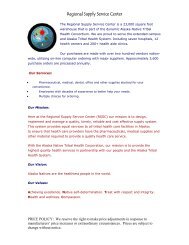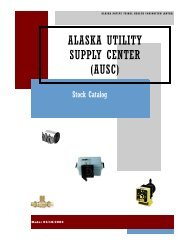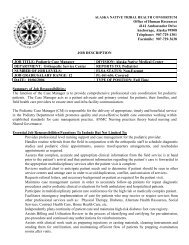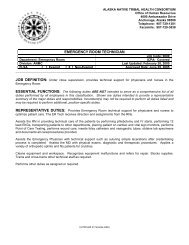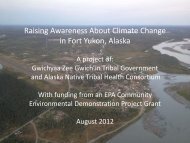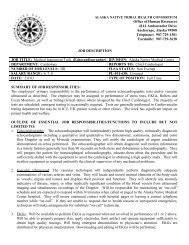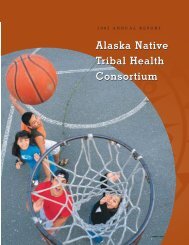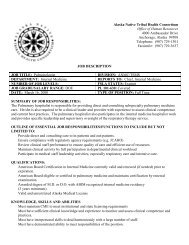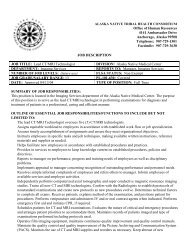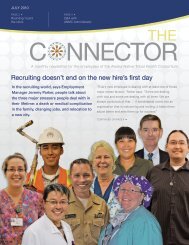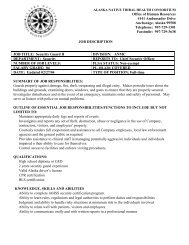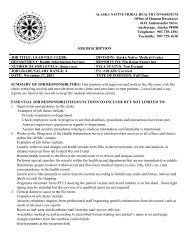Draft Final Climate Change and Health Impacts Point ... - ANTHC
Draft Final Climate Change and Health Impacts Point ... - ANTHC
Draft Final Climate Change and Health Impacts Point ... - ANTHC
Create successful ePaper yourself
Turn your PDF publications into a flip-book with our unique Google optimized e-Paper software.
youths <strong>and</strong> presentations were made to junior high, high school, <strong>and</strong> elementary level students at the<br />
Tikigaq School. Photographs <strong>and</strong> video of local conditions were recorded where possible.<br />
Information from interviews was collected <strong>and</strong> recorded in the <strong>Climate</strong> <strong>and</strong> <strong>Health</strong> Measure (CAHM), a<br />
survey tool used to organize local observations, <strong>and</strong> record potential health effects, data gaps <strong>and</strong><br />
adaptation measures. Local <strong>and</strong> regional partners reviewed the CAHM <strong>and</strong> provided comments on the<br />
draft report.<br />
Findings were presented to partner organizations in <strong>Point</strong> Hope, Kotzebue, <strong>and</strong> Barrow, <strong>and</strong> efforts are<br />
on‐going to connect local <strong>and</strong> regional leadership with climate change experts <strong>and</strong> to identify resources<br />
that will encourage implementation of community appropriate adaptation measures.<br />
COMMUNITY PROFILE<br />
<strong>Point</strong> Hope is located 330 miles southwest of Barrow <strong>and</strong> 180 miles north of Kotzebue (Alaska Division<br />
of Community Advocacy, 2009). It is near the tip of Tigara Peninsula, a gravel spit that is the western<br />
most point on the Northwest Alaska coast (Figure 3). It is also within the boundaries of the North Slope<br />
Borough <strong>and</strong> receives health services from the Maniilaq Association. All other communities served by<br />
Maniilaq are located in the Northwest Arctic Borough.<br />
The Chukchi Sea surrounds the <strong>Point</strong> Hope promontory on three sides but the near shore waters are<br />
very shallow; up to five miles from the shore, the water reaches depths of only 60 feet. Tides do not<br />
have a direct impact on <strong>Point</strong> Hope, but strong ocean currents bring waters north through the Bering<br />
Strait. Sea ice can be present from October to early July. Sediments deposited by the Ipewik <strong>and</strong> Kukpuk<br />
branches of the Kuukpak River form beach ridges that extend into the sea in a triangular shape. The<br />
mountainous areas reach elevations of 1,000 to 2,000 feet in the Lisburne Hills to the north <strong>and</strong> the<br />
Kemegrak Hills to the south.<br />
The Tigara (Tikeraq) Peninsula, named for the Inupiaq word for index finger, dates back to 600 B.C as<br />
one of the oldest continuously occupied Iñupiat marine mammal hunting communities in the Arctic.<br />
Commercial whaling came to <strong>Point</strong> Hope in the 1800s, including shore‐based stations. For the next 100<br />
years commercial whaling exerted a powerful influence on <strong>Point</strong> Hope, providing jobs, but also<br />
increasing exposure to western goods, technology, culture, <strong>and</strong> disease. The City of <strong>Point</strong> Hope was<br />
incorporated in 1966. The Native Village of <strong>Point</strong> Hope is the federally recognized tribal government.<br />
In 1990, <strong>Point</strong> Hope had a total population of 639. In 2000, the population was 757, with 91% Alaska<br />
Native. In 2000, 25.71% of the population was employed <strong>and</strong> 51.32% of adults were not in the<br />
workforce. The median household income was $63,125, per capita income was $16,641, <strong>and</strong> 14.83% of<br />
residents were living below the poverty level (DCCED, 2009). Most full‐time employment is with the city,<br />
tribal <strong>and</strong> borough governments, or with Tikigaq, the local Alaska Native for‐profit corporation formed<br />
under the Alaska Native Claims Settlement Act.<br />
Residents are active year‐round with subsistence activities for seals, walrus, bowhead whales, beluga<br />
whales, caribou, polar bears, birds, fish <strong>and</strong> berries, greens, <strong>and</strong> other edible plants. Commercial fishing<br />
is limited; in 2000, only two residents held a commercial fishing permit. Whalebone masks, baleen<br />
baskets, ivory carvings, <strong>and</strong> Inupiat clothing are manufactured locally. <strong>Point</strong> Hope is a dry community,<br />
where the sale, importation or possession of alcohol is banned.<br />
7



